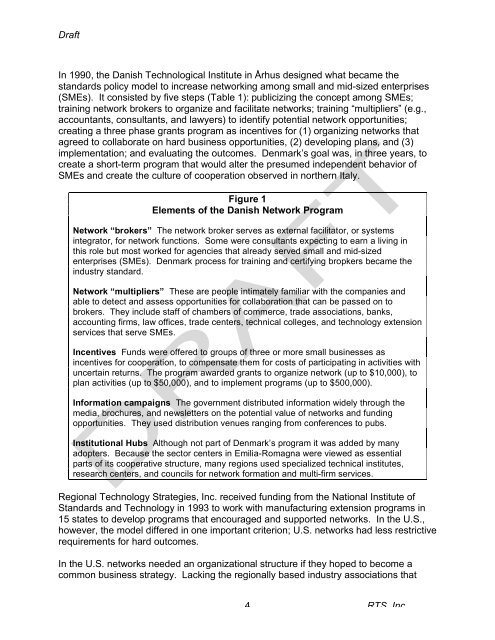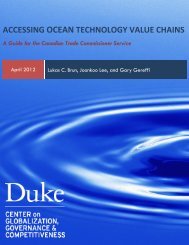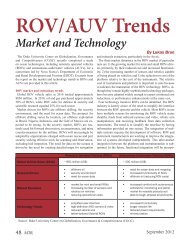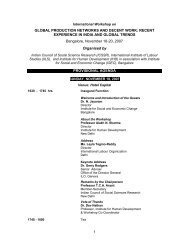Paper - Center on Globalization, Governance & Competitiveness
Paper - Center on Globalization, Governance & Competitiveness
Paper - Center on Globalization, Governance & Competitiveness
Create successful ePaper yourself
Turn your PDF publications into a flip-book with our unique Google optimized e-Paper software.
Draft<br />
In 1990, the Danish Technological Institute in Århus designed what became the<br />
standards policy model to increase networking am<strong>on</strong>g small and mid-sized enterprises<br />
(SMEs). It c<strong>on</strong>sisted by five steps (Table 1): publicizing the c<strong>on</strong>cept am<strong>on</strong>g SMEs;<br />
training network brokers to organize and facilitate networks; training “multipliers” (e.g.,<br />
accountants, c<strong>on</strong>sultants, and lawyers) to identify potential network opportunities;<br />
creating a three phase grants program as incentives for (1) organizing networks that<br />
agreed to collaborate <strong>on</strong> hard business opportunities, (2) developing plans, and (3)<br />
implementati<strong>on</strong>; and evaluating the outcomes. Denmark’s goal was, in three years, to<br />
create a short-term program that would alter the presumed independent behavior of<br />
SMEs and create the culture of cooperati<strong>on</strong> observed in northern Italy.<br />
Figure 1<br />
Elements of the Danish Network Program<br />
Network “brokers” The network broker serves as external facilitator, or systems<br />
integrator, for network functi<strong>on</strong>s. Some were c<strong>on</strong>sultants expecting to earn a living in<br />
this role but most worked for agencies that already served small and mid-sized<br />
enterprises (SMEs). Denmark process for training and certifying bropkers became the<br />
industry standard.<br />
Network “multipliers” These are people intimately familiar with the companies and<br />
able to detect and assess opportunities for collaborati<strong>on</strong> that can be passed <strong>on</strong> to<br />
brokers. They include staff of chambers of commerce, trade associati<strong>on</strong>s, banks,<br />
accounting firms, law offices, trade centers, technical colleges, and technology extensi<strong>on</strong><br />
services that serve SMEs.<br />
Incentives Funds were offered to groups of three or more small businesses as<br />
incentives for cooperati<strong>on</strong>, to compensate them for costs of participating in activities with<br />
uncertain returns. The program awarded grants to organize network (up to $10,000), to<br />
plan activities (up to $50,000), and to implement programs (up to $500,000).<br />
Informati<strong>on</strong> campaigns The government distributed informati<strong>on</strong> widely through the<br />
media, brochures, and newsletters <strong>on</strong> the potential value of networks and funding<br />
opportunities. They used distributi<strong>on</strong> venues ranging from c<strong>on</strong>ferences to pubs.<br />
Instituti<strong>on</strong>al Hubs Although not part of Denmark’s program it was added by many<br />
adopters. Because the sector centers in Emilia-Romagna were viewed as essential<br />
parts of its cooperative structure, many regi<strong>on</strong>s used specialized technical institutes,<br />
research centers, and councils for network formati<strong>on</strong> and multi-firm services.<br />
Regi<strong>on</strong>al Technology Strategies, Inc. received funding from the Nati<strong>on</strong>al Institute of<br />
Standards and Technology in 1993 to work with manufacturing extensi<strong>on</strong> programs in<br />
15 states to develop programs that encouraged and supported networks. In the U.S.,<br />
however, the model differed in <strong>on</strong>e important criteri<strong>on</strong>; U.S. networks had less restrictive<br />
requirements for hard outcomes.<br />
In the U.S. networks needed an organizati<strong>on</strong>al structure if they hoped to become a<br />
comm<strong>on</strong> business strategy. Lacking the regi<strong>on</strong>ally based industry associati<strong>on</strong>s that<br />
4<br />
RTS, Inc.
















